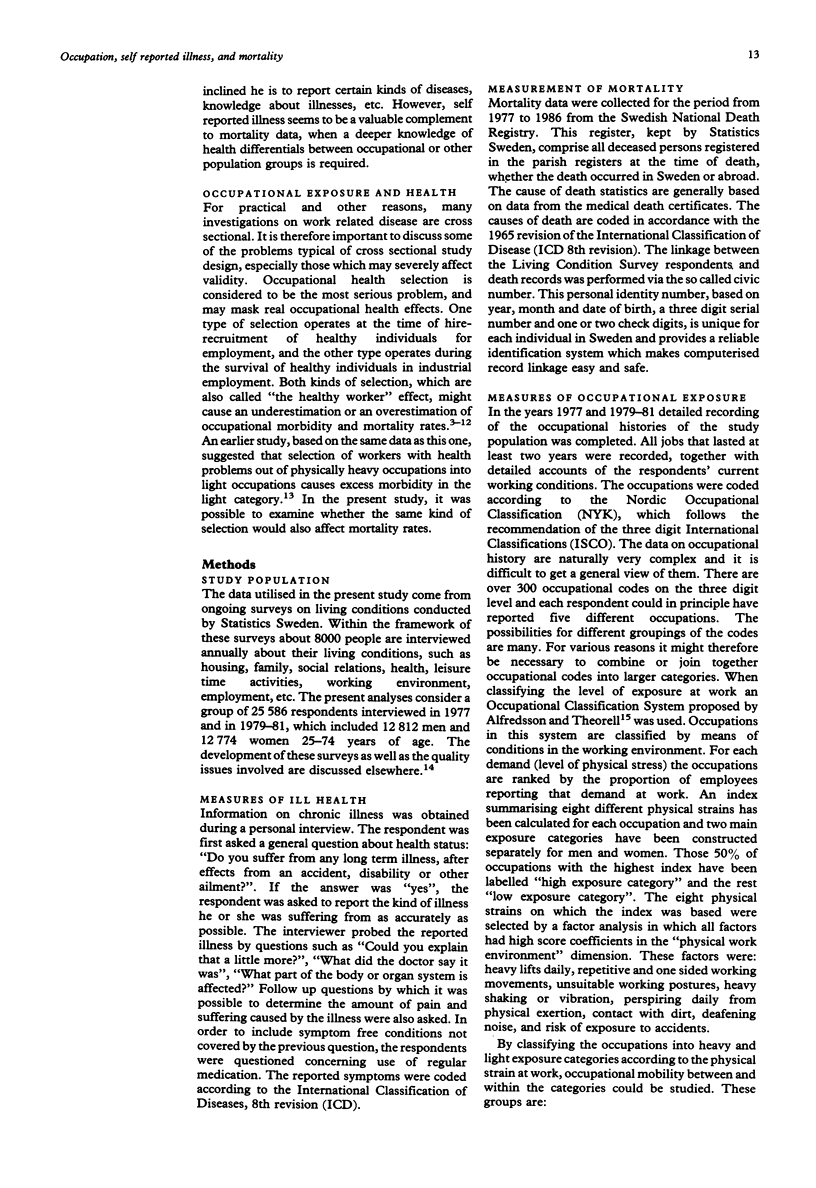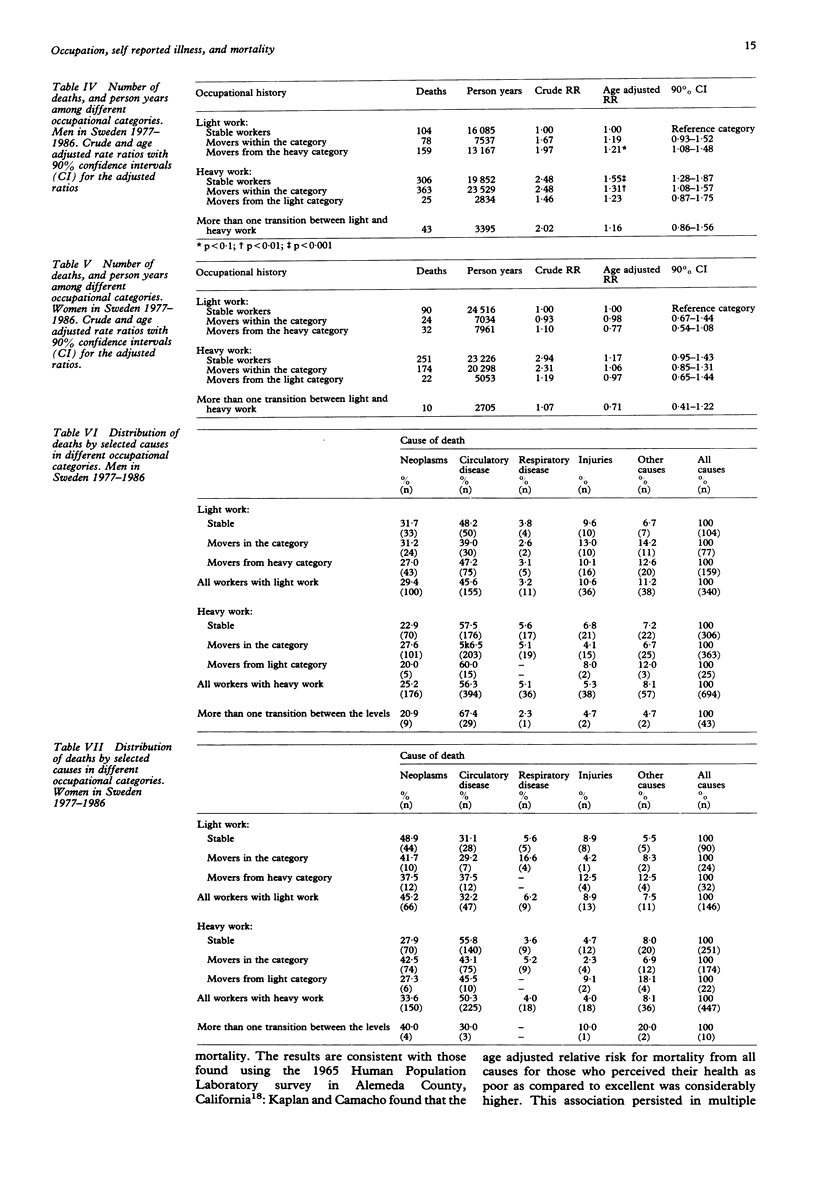Abstract
STUDY OBJECTIVE--The aim of the study was to analyse the extent to which mortality can be predicted from data on self assessed chronic illness. DESIGN--The study used data obtained from ongoing surveys of living conditions conducted by Statistics Sweden using annual interviews of cohorts of about 8000 people. SETTING--The study was a population based survey of the whole of Sweden. PARTICIPANTS--The analysis involved a group of 25,586 respondents (males 12,812, females 12,774), aged 25-74 years, interviewed in 1977 and 1979-81. MEASUREMENTS AND RESULTS--Mortality and occupational health selection were analysed in different occupational categories. The association between mortality and self reported morbidity was assessed. Level of physical strain at work was associated with mortality in men. Occupational health selection could be detected for men but not for women when mortality from all causes was investigated. Self assessment of health predicted mortality. CONCLUSIONS--Subjective assessments of health through surveys are valuable as predictors of mortality for both men and women.
Full text
PDF




Selected References
These references are in PubMed. This may not be the complete list of references from this article.
- Anderson J. A. Shoulder pain and tension neck and their relation to work. Scand J Work Environ Health. 1984 Dec;10(6 Spec No):435–442. doi: 10.5271/sjweh.2300. [DOI] [PubMed] [Google Scholar]
- Brennan M. E., Clare P. H. The relationship between mortality and two indicators of morbidity. J Epidemiol Community Health. 1980 Jun;34(2):134–138. doi: 10.1136/jech.34.2.134. [DOI] [PMC free article] [PubMed] [Google Scholar]
- Carpenter L. M. Some observations on the healthy worker effect. Br J Ind Med. 1987 May;44(5):289–291. doi: 10.1136/oem.44.5.289. [DOI] [PMC free article] [PubMed] [Google Scholar]
- Forster D. P. Mortality, morbidity, and resource allocation. Lancet. 1977 May 7;1(8019):997–998. doi: 10.1016/s0140-6736(77)92291-7. [DOI] [PubMed] [Google Scholar]
- Fox A. J., Goldblatt P. O., Adelstein A. M. Selection and mortality differentials. J Epidemiol Community Health. 1982 Jun;36(2):69–79. doi: 10.1136/jech.36.2.69. [DOI] [PMC free article] [PubMed] [Google Scholar]
- Hunt S. M., McEwen J., McKenna S. P. Perceived health: age and sex comparisons in a community. J Epidemiol Community Health. 1984 Jun;38(2):156–160. doi: 10.1136/jech.38.2.156. [DOI] [PMC free article] [PubMed] [Google Scholar]
- Hunt S. M., McKenna S. P., McEwen J., Backett E. M., Williams J., Papp E. A quantitative approach to perceived health status: a validation study. J Epidemiol Community Health. 1980 Dec;34(4):281–286. doi: 10.1136/jech.34.4.281. [DOI] [PMC free article] [PubMed] [Google Scholar]
- Kaplan G. A., Camacho T. Perceived health and mortality: a nine-year follow-up of the human population laboratory cohort. Am J Epidemiol. 1983 Mar;117(3):292–304. doi: 10.1093/oxfordjournals.aje.a113541. [DOI] [PubMed] [Google Scholar]
- Koskela R. S. Occupational mortality and morbidity in relation to selective turnover. Scand J Work Environ Health. 1982;8 (Suppl 1):34–39. [PubMed] [Google Scholar]
- Mossey J. M., Shapiro E. Self-rated health: a predictor of mortality among the elderly. Am J Public Health. 1982 Aug;72(8):800–808. doi: 10.2105/ajph.72.8.800. [DOI] [PMC free article] [PubMed] [Google Scholar]
- Mägi M., Allander E., Bjelle A., Ragnarsson A. Rheumatic disorders in a health survey: how valid and reliable are the reports? Scand J Soc Med. 1984;12(4):141–146. doi: 10.1177/140349488401200403. [DOI] [PubMed] [Google Scholar]
- Olsen J. Some methodologic problems encountered in occupational health research. Scand J Soc Med. 1981;9(1):19–24. doi: 10.1177/140349488100900103. [DOI] [PubMed] [Google Scholar]
- Ostlin P. Negative health selection into physically light occupations. J Epidemiol Community Health. 1988 Jun;42(2):152–156. doi: 10.1136/jech.42.2.152. [DOI] [PMC free article] [PubMed] [Google Scholar]
- Ostlin P., Thorslund M. Problems with cross-sectional data in research on working environment and health. Scand J Soc Med. 1988;16(3):139–143. doi: 10.1177/140349488801600303. [DOI] [PubMed] [Google Scholar]
- Page W. F. Mortality and morbidity selection effects among US veterans. J Occup Med. 1987 Dec;29(12):975–978. [PubMed] [Google Scholar]
- Sterling T. D., Weinkam J. J. The 'healthy worker effect' on morbidity rates. J Occup Med. 1985 Jul;27(7):477–482. [PubMed] [Google Scholar]
- Troup J. D. Causes, prediction and prevention of back pain at work. Scand J Work Environ Health. 1984 Dec;10(6 Spec No):419–428. doi: 10.5271/sjweh.2318. [DOI] [PubMed] [Google Scholar]
- Vinni K., Hakama M. Healthy worker effect in the total Finnish population. Br J Ind Med. 1980 May;37(2):180–184. doi: 10.1136/oem.37.2.180. [DOI] [PMC free article] [PubMed] [Google Scholar]
- Weed D. L., Tyroler H. A., Shy C. The healthy worker effect in actively working communications workers. J Occup Med. 1987 Apr;29(4):335–339. [PubMed] [Google Scholar]
- Wilcosky T., Wing S. The healthy worker effect. Selection of workers and work forces. Scand J Work Environ Health. 1987 Feb;13(1):70–72. doi: 10.5271/sjweh.2078. [DOI] [PubMed] [Google Scholar]


